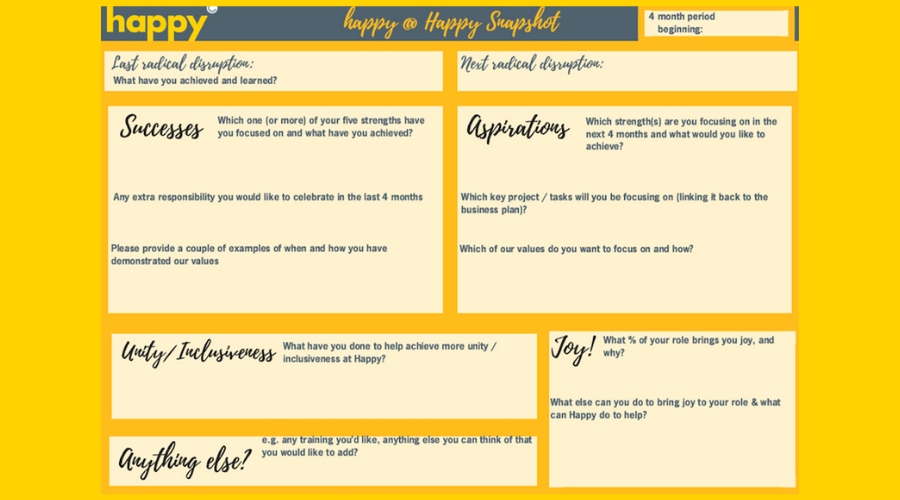Let's get rid of annual appraisals and replace them with snapshots
Around three years ago my colleague Cathy Busani organised a vote of all our employees on whether they wanted to keep the annual appraisal. As she expected, they didn’t – with 83% voting to scrap them.
Of course it still makes sense to carry out a regular review, so we replaced it with a four monthly happy@happy snapshot. Find out more in this blog.
Get in touch

We are not alone in getting rid of appraisals. A whole range of organisations have decided to abolish annual appraisals, from Dell and Microsoft to Hackney Council. As Elaine Pulakos, CEO of PDRI, puts it in this BBC article, appraisals “end up being extremely costly and have no impact on productivity”. Research from Gallup found that performance appraisals actually made performance worse in a third of cases!
We replaced appraisals with a four-monthly happy@happy snapshot. The form we use is above, inspired by something we saw at the fabulous food company Cook. Here’s what it includes:
Radical Disruption
We used to have targets, set by the individual. We even tried OKRs. I know many people swear by them but they didn’t work here at Happy. One issue with targets is that some of our people, such as our facilitators, might have the same targets (feedback scores, income generated) for years.
Then at one of our regular Happy Days, somebody came up with the idea of choosing just one thing, one thing that you will do completely differently in the next period. It could be a new product. It could be learning something challenging.
For one of my colleagues it was to get out of a cycle of being endlessly busy and hectic. Focusing on it for four months she managed to move to a way of working that was less busy, more relaxed and more productive.
Strengths
People are happier and more productive if you are playing to your strengths. So we use Clifton Strengths (was the StrengthsFinder) to discover each person’s five key strengths, as well as working with them on what motivates them and what makes them “feel magnificent”.
We want people to do what they are good at, for their sake and for Happy’s. So we explore which strengths they have used and which they will use going ahead. On our admin team they regularly get together, take all the jobs, put them all on post-its and work out which best play to what each person is good at. (Cathy spoke about how everyone at Happy works to their strengths at the 2019 Happy Workplaces Conference — watch our short clip What Would Your Team Be Like if Everyone Was Working to Their Strengths? to learn more.)
Responsibilities
At Happy people aren’t generally given responsibilities or promotions. Instead we encourage people to seek opportunities, to decide what responsibility they are able to take on.
One example was two of our front-line staff who decided our prices needed updating. As is the Happy way, they consulted with colleagues and clients and checked the market. And then they took responsibility and made the decision, without needing upward approval, on what to change to.
Values
We don’t want our core values to be just a laminated poster stuck on the wall. So the snapshot is a good opportunity to explore where we have “believed the best”, “helped people feel good about themselves”, “celebrated mistakes”, “delighted the customer” or “made the world a better place”.
One example of customer delight is a colleague who had overheard a client saying how much they liked the chairs in our café. When she heard, months later, that we were changing the café around and getting rid of those chairs, she got in contact with him and taxied them over for free. “He was so pleased.”
Unity/Inclusiveness
It is not enough at Happy to be good at your core job. Our values are clear and we expect everybody to be positive and supportive of others and – even in a difficult conversation – to leave them feeling good about themselves.
So a crucial element of the form is to ask what they have done to achieve more unity and inclusiveness. That can be anything from little things like taking lunch with different colleagues or checking in with people in other departments..
Joy at Work
Our aim is that everybody at Happy finds joy in their work at least 80% of the time. We ask our people to measure it for themselves and to think about what would bring them joy.
And it leads to a very different conversation to ask “what would give you more joy?”, instead of “how can we improve your performance?”.
For one of my colleagues its actually about her relationship with her manager (or our equivalent, termed M&M – multiplier and mentor). “She encourages me to put less pressure on myself, to be kinder to myself. That brings me joy.”
In conclusion
This works well for us. What would be your equivalents for a regular check in? And, if you still have annual performance appraisals, is it time to do away with them? Do they really serve a purpose?
Why not sign up to our newsletter?
Sign up to our monthly newsletter, full of tips, tricks and news to help you to be happier and more productive at work.
Henry's Most Popular Blogs
- 8 Companies That Celebrate Mistakes
- 9 Benefits of Having Happy Employees
- 321Zero: How I Solved my Email Overload
- 16 Companies That Don't Have Managers
- 5 Big Companies Who Swear by Mindfulness
- 49 Steps to a Happy Workplace
- A Four Day Week? Let's Start With a Four Day August
- Google: Hire Great People and Give Them Lots of Autonomy
- Buurtzorg: No Managers, Just Great Care From a Nurse-Led Service
- 30 Steps to Joy at Work: Get More Done by Being Less Busy
Learn more leadership skills in these upcoming workshops
A happy workplace leads to greater productivity and tangible business results. We have developed a range of leadership programmes focusing on the skills you need to develop a happy workplace, based upon our own practical experience at Happy and learning from some of the world’s great workplaces.
Here are just some of the public course dates coming up in the next few months:
- Management Fundamentals — a two-day workshop designed for new managers to help you understand what makes a great manager and the practical steps you can take to make it happen. Learn at Happy on the 29th July over 2 days, or from 22nd October over 2 days, held online.
- The Happy Leadership Programme — our flagship four-day leadership course. Join us in the next classroom session on 14th January 2026. Or online for our eight-day session on 23rd September.
- Brave Leadership — this is a one-year leadership development programme for women. This programme is about unleashing your brilliance, as well as identifying and enabling greatness in others. It will also create, and connect you to, a network of inspirational women. Our next programme starts from 28th January, for 12 sessions held monthly.
All of these programmes are also available to book as private group courses for your organisation. Get in touch with our friendly team to find out more details including pricing and availability.
Why choose Happy?
- Learn the skills you need to succeed
- Fun and interactive workshops, whether online or face-to-face
- Learn in a confidential environment with our experienced facilitators
- Small class sizes to give personal one-to-one support
- Private group options available
- No quibble money-back guarantee on all courses

Henry Stewart, Founder and Chief Happiness Officer
Henry is founder and Chief Happiness Officer of Happy Ltd, originally set up as Happy Computers in 1987. Inspired by Ricardo Semler’s book Maverick, he has built a company which has won multiple awards for some of the best customer service in the country and being one of the UK’s best places to work.
Henry was listed in the Guru Radar of the Thinkers 50 list of the most influential management thinkers in the world. "He is one of the thinkers who we believe will shape the future of business," explained list compiler Stuart Crainer.
His first book, Relax, was published in 2009. His second book, the Happy Manifesto, was published in 2013 and was short-listed for Business Book of the Year.
You can find Henry on LinkedIn and follow @happyhenry on Twitter.
